8.3: The Early Empire
- Page ID
- 53010
\( \newcommand{\vecs}[1]{\overset { \scriptstyle \rightharpoonup} {\mathbf{#1}} } \)
\( \newcommand{\vecd}[1]{\overset{-\!-\!\rightharpoonup}{\vphantom{a}\smash {#1}}} \)
\( \newcommand{\dsum}{\displaystyle\sum\limits} \)
\( \newcommand{\dint}{\displaystyle\int\limits} \)
\( \newcommand{\dlim}{\displaystyle\lim\limits} \)
\( \newcommand{\id}{\mathrm{id}}\) \( \newcommand{\Span}{\mathrm{span}}\)
( \newcommand{\kernel}{\mathrm{null}\,}\) \( \newcommand{\range}{\mathrm{range}\,}\)
\( \newcommand{\RealPart}{\mathrm{Re}}\) \( \newcommand{\ImaginaryPart}{\mathrm{Im}}\)
\( \newcommand{\Argument}{\mathrm{Arg}}\) \( \newcommand{\norm}[1]{\| #1 \|}\)
\( \newcommand{\inner}[2]{\langle #1, #2 \rangle}\)
\( \newcommand{\Span}{\mathrm{span}}\)
\( \newcommand{\id}{\mathrm{id}}\)
\( \newcommand{\Span}{\mathrm{span}}\)
\( \newcommand{\kernel}{\mathrm{null}\,}\)
\( \newcommand{\range}{\mathrm{range}\,}\)
\( \newcommand{\RealPart}{\mathrm{Re}}\)
\( \newcommand{\ImaginaryPart}{\mathrm{Im}}\)
\( \newcommand{\Argument}{\mathrm{Arg}}\)
\( \newcommand{\norm}[1]{\| #1 \|}\)
\( \newcommand{\inner}[2]{\langle #1, #2 \rangle}\)
\( \newcommand{\Span}{\mathrm{span}}\) \( \newcommand{\AA}{\unicode[.8,0]{x212B}}\)
\( \newcommand{\vectorA}[1]{\vec{#1}} % arrow\)
\( \newcommand{\vectorAt}[1]{\vec{\text{#1}}} % arrow\)
\( \newcommand{\vectorB}[1]{\overset { \scriptstyle \rightharpoonup} {\mathbf{#1}} } \)
\( \newcommand{\vectorC}[1]{\textbf{#1}} \)
\( \newcommand{\vectorD}[1]{\overrightarrow{#1}} \)
\( \newcommand{\vectorDt}[1]{\overrightarrow{\text{#1}}} \)
\( \newcommand{\vectE}[1]{\overset{-\!-\!\rightharpoonup}{\vphantom{a}\smash{\mathbf {#1}}}} \)
\( \newcommand{\vecs}[1]{\overset { \scriptstyle \rightharpoonup} {\mathbf{#1}} } \)
\(\newcommand{\longvect}{\overrightarrow}\)
\( \newcommand{\vecd}[1]{\overset{-\!-\!\rightharpoonup}{\vphantom{a}\smash {#1}}} \)
\(\newcommand{\avec}{\mathbf a}\) \(\newcommand{\bvec}{\mathbf b}\) \(\newcommand{\cvec}{\mathbf c}\) \(\newcommand{\dvec}{\mathbf d}\) \(\newcommand{\dtil}{\widetilde{\mathbf d}}\) \(\newcommand{\evec}{\mathbf e}\) \(\newcommand{\fvec}{\mathbf f}\) \(\newcommand{\nvec}{\mathbf n}\) \(\newcommand{\pvec}{\mathbf p}\) \(\newcommand{\qvec}{\mathbf q}\) \(\newcommand{\svec}{\mathbf s}\) \(\newcommand{\tvec}{\mathbf t}\) \(\newcommand{\uvec}{\mathbf u}\) \(\newcommand{\vvec}{\mathbf v}\) \(\newcommand{\wvec}{\mathbf w}\) \(\newcommand{\xvec}{\mathbf x}\) \(\newcommand{\yvec}{\mathbf y}\) \(\newcommand{\zvec}{\mathbf z}\) \(\newcommand{\rvec}{\mathbf r}\) \(\newcommand{\mvec}{\mathbf m}\) \(\newcommand{\zerovec}{\mathbf 0}\) \(\newcommand{\onevec}{\mathbf 1}\) \(\newcommand{\real}{\mathbb R}\) \(\newcommand{\twovec}[2]{\left[\begin{array}{r}#1 \\ #2 \end{array}\right]}\) \(\newcommand{\ctwovec}[2]{\left[\begin{array}{c}#1 \\ #2 \end{array}\right]}\) \(\newcommand{\threevec}[3]{\left[\begin{array}{r}#1 \\ #2 \\ #3 \end{array}\right]}\) \(\newcommand{\cthreevec}[3]{\left[\begin{array}{c}#1 \\ #2 \\ #3 \end{array}\right]}\) \(\newcommand{\fourvec}[4]{\left[\begin{array}{r}#1 \\ #2 \\ #3 \\ #4 \end{array}\right]}\) \(\newcommand{\cfourvec}[4]{\left[\begin{array}{c}#1 \\ #2 \\ #3 \\ #4 \end{array}\right]}\) \(\newcommand{\fivevec}[5]{\left[\begin{array}{r}#1 \\ #2 \\ #3 \\ #4 \\ #5 \\ \end{array}\right]}\) \(\newcommand{\cfivevec}[5]{\left[\begin{array}{c}#1 \\ #2 \\ #3 \\ #4 \\ #5 \\ \end{array}\right]}\) \(\newcommand{\mattwo}[4]{\left[\begin{array}{rr}#1 \amp #2 \\ #3 \amp #4 \\ \end{array}\right]}\) \(\newcommand{\laspan}[1]{\text{Span}\{#1\}}\) \(\newcommand{\bcal}{\cal B}\) \(\newcommand{\ccal}{\cal C}\) \(\newcommand{\scal}{\cal S}\) \(\newcommand{\wcal}{\cal W}\) \(\newcommand{\ecal}{\cal E}\) \(\newcommand{\coords}[2]{\left\{#1\right\}_{#2}}\) \(\newcommand{\gray}[1]{\color{gray}{#1}}\) \(\newcommand{\lgray}[1]{\color{lightgray}{#1}}\) \(\newcommand{\rank}{\operatorname{rank}}\) \(\newcommand{\row}{\text{Row}}\) \(\newcommand{\col}{\text{Col}}\) \(\renewcommand{\row}{\text{Row}}\) \(\newcommand{\nul}{\text{Nul}}\) \(\newcommand{\var}{\text{Var}}\) \(\newcommand{\corr}{\text{corr}}\) \(\newcommand{\len}[1]{\left|#1\right|}\) \(\newcommand{\bbar}{\overline{\bvec}}\) \(\newcommand{\bhat}{\widehat{\bvec}}\) \(\newcommand{\bperp}{\bvec^\perp}\) \(\newcommand{\xhat}{\widehat{\xvec}}\) \(\newcommand{\vhat}{\widehat{\vvec}}\) \(\newcommand{\uhat}{\widehat{\uvec}}\) \(\newcommand{\what}{\widehat{\wvec}}\) \(\newcommand{\Sighat}{\widehat{\Sigma}}\) \(\newcommand{\lt}{<}\) \(\newcommand{\gt}{>}\) \(\newcommand{\amp}{&}\) \(\definecolor{fillinmathshade}{gray}{0.9}\)Imperial Sculpture in the Early Roman Empire
Augustan art served a vital visual means to promote the legitimacy of Augustus’ power, and the techniques he employed were incorporated into the propaganda of later emperors.
Describe the elements of propaganda in Augustan art and in the art commissioned by later emperors
Key Points
- The intricate and deliberate iconography of Ara Pacis Augustae promotes religious piety, fertility, and the flourishing of the empire under Augustus.
- Augustus abandoned the veristic portraiture of the Roman Republic in favor of creating an image of a forever-youthful emperor. His imperial portraits often promoted his piety and military accomplishments.
- Augustus’s successor, Tiberius, and the penultimate Julio-Claudian emperor Claudius, employed the attributes of eternal youthfulness and prowess in their political portraiture as a measure of political promotion.
Key Terms
- meander: A decorative border constructed from a continuous line, shaped into a repeated motif.
- lictors: The bodyguards for a magistrate in the Republican Rome and emperors during Imperial Rome. They carried fasces, a bundle of wooden rods with an axe, which symbolized the power of the magistrate or emperor.
- cuirass: A metal breastplate that serves as armor.
- pomerium: The sacred boundary around a city that marked the city’s urban, legal, and religious limits. No armies were allowed within this boundary.
- register: A vertical level in a work that consists of several levels, especially where the levels are clearly separated by lines.
Augustus
During his reign, Augustus enacted an effective propaganda campaign to promote the legitimacy of his rule as well as to encourage moral and civic ideals among the Roman populace.
Augustan sculpture contains the rich iconography of Augustus’s reign with its strong themes of legitimacy, stability, fertility, prosperity, and religious piety. The visual motifs employed within this iconography became the standards for imperial art.
Ara Pacis Augustae
The Ara Pacis Augustae, or Altar of Augustan Peace, is one of the best examples of Augustan artistic propaganda. Not only does it demonstrate a new moral code promoted by Augustus, it also established imperial iconography. It was commissioned by the Senate in 13 BCE to honor the peace and bounty established by Augustus following his return from Hispania (Spain) and Gaul; it was consecrated on January 30, 9 BCE.
The marble altar was erected just outside the boundary of the pomerium to the north of the city along the Via Flaminia on the Campus Martius. The actual u-shaped altar sits atop a podium inside a square wall that demarcates the precinct’s sacred space .
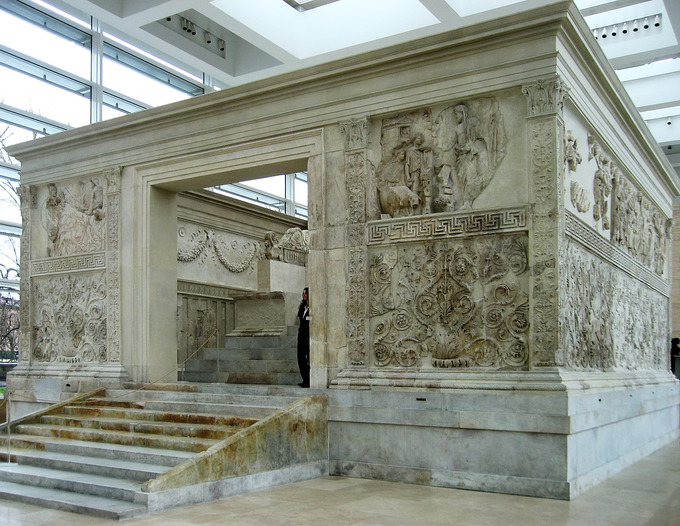
The north and south walls depict a procession of life-sized figures on the upper register . These figures include men, women, children, priests, lictors , and identifiable members of the political elite during the Augustan age. The elite include Augustus, his wife Livia, his son-in-law Marcus Agrippa (who died in 12 BCE), and Tiberius, Augustus’s adopted son and successor who would marry the emperor’s widowed daughter in 11 BCE. While the altar as a whole celebrates the Augustus as a peacemaker, this scene promotes him as a pious family man.
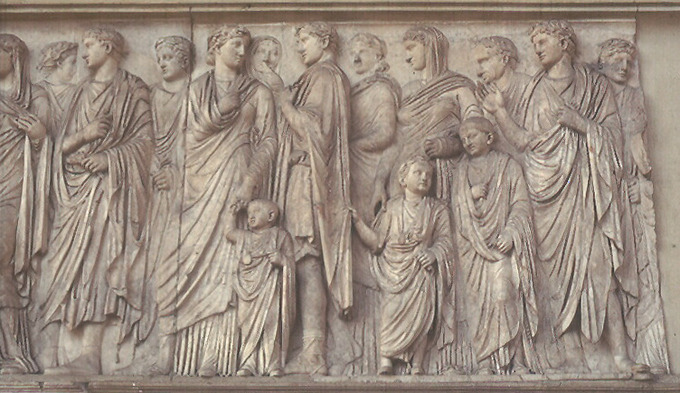
Imperial Portraiture
Augustus very carefully controlled his imperial portrait. Abandoning the veristic style of the Republican period, his portraits always showed him as an idealized young man. These portraits linked him to divinities and heroes, both mythical and historical.
He is often shown with an identifiable cowlick that was originally shown on the portraits of Alexander the Great . His lack of shoes signifies his supposed humbleness despite the great power he possessed. Two portraits of him, one as Pontifex Maximus and the other as Imperator , depict two different personae of the emperor.
Augustus’s portrait as Pontifex Maximus shows him attired with a toga over his ever-youthful head, an attribute that serves to remind viewers of his own extreme piety to the gods.
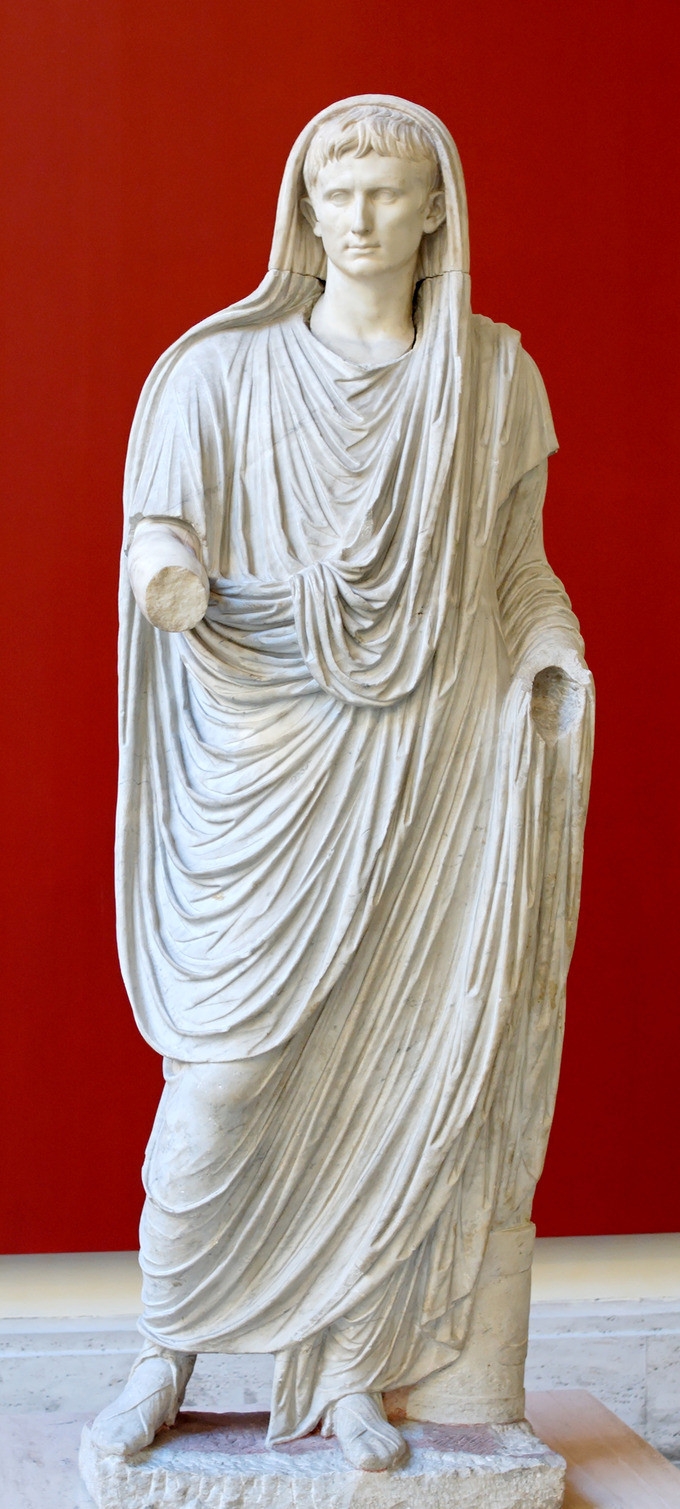
The Augustus of Primaporta shows the influence of both Roman and Classical Greek works, including the Spear Bearer by Polykleitos and the Etruscan bronze Aule Metele. Assuming the role of imperator, Augustus wears military grab in a pose known as adlucotio, addressing his troops. Despite his poor health, which left him with a frail body, he appears healthy and muscular.
Cupid rides a dolphin at Augustus’ feet, a symbol of his divine ancestry. Cupid is the son of Venus, as was Aeneas, the legendary ancestor of the Roman people. The Julian family traced their ancestry back to Aeneas and, therefore, consider themselves descendants of Venus.
As Caesar’s nephew and adopted son, this use of iconography allows Augustus to remind viewers of his divine lineage. In addition to adopting the body language and attire of a general, the relief on the cuirass shows one of Augustus’ greatest victories—the return of the Parthian standards.
During the civil wars, a legion’s standards were lost when the legion was defeated by the Parthians . In a great feat of diplomacy, and curiously not military action, Augustus was able to negotiate the return of the standards to the legion and to Rome . Additional figures on the cuirass personify Roman gods and the arrival of Augustan peace.
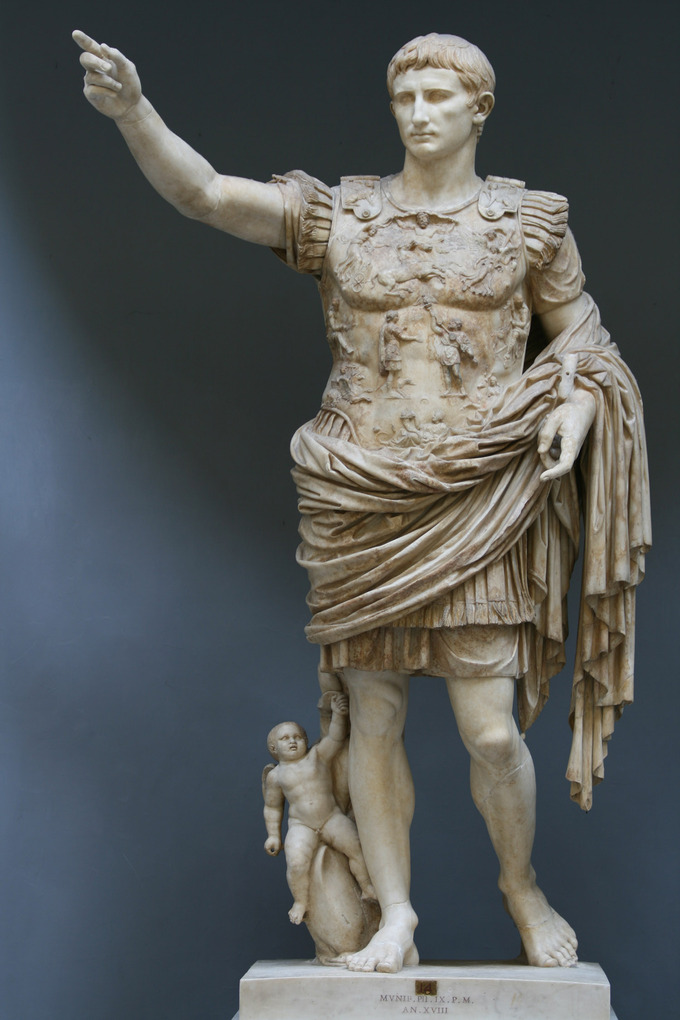
The Legacy of Augustan Sculpture
Upon the death of Augustus, Tiberius (14–37 CE) assumed the title of emperor and Pontifex Maximus of Rome. Like his father-in-law, Tiberius maintained a youthful appearance in his portraiture in sculpture.
A general in his pre-imperial career, Tiberius appears in a sculpture very similar to the Augustus of Primaporta. He wears military attire and stands erect in a dynamic contrapposto pose with his arm raised. Although he wears boots, which would appear to contradict the suggestion of humbleness seen in full-length sculptures of Augustus, his plain cuirass and the absence of religious iconography suggest a competent leader who does not promote his accomplishments or divine ancestry.
Like Augustus, who suffered from poor health, Claudius, who succeeded Caligula in 41 CE, was also infirm. In addition to health issues, Claudius lacked experience as a leader but quickly overcame this shortcoming as emperor.
During his reign, Rome annexed the province of Britannia (present-day England and Wales) and witnessed the construction of new roads and aqueducts . Despite these achievements, Claudius’s opponents still saw him as vulnerable, a situation that forced him to shore up his position almost constantly, resulting in the deaths of many senators. Perhaps this need to prove his competency in his role prompted him to commission a sculpture of himself as Jupiter, a sculpture that also bears striking similarities to the Augustus of Primaporta.
He continues the standard of the eternally youthful and healthy emperor begun by Augustus. His face and body are idealized. Like his predecessor, Claudius appears barefoot in a gesture of humility balanced with a symbol of divinity, in this case, an eagle to symbolize Jupiter. He wears a laurel crown as a metaphor of victory. While the positions of his arms and hand are similar to those of Augustus, Claudius holds a bowl (an offering to signify his piety) in one hand and a scepter-like object (to signify his power) in the other.
Architecture of the Early Roman Empire
The Julio-Claudian and Flavian dynasties of the early Roman Empire oversaw some of the best-known building projects of the era.
Identify the prominent architectural accomplishments of the early Roman Empire
Key Points
- The first Roman emperor, Augustus, was said to have transformed Rome from a city of brick to one of marble. One of the projects of his reign was the rebuilding of the Basilica Julia, named in honor of his adopted father Julius Caesar. Elements of its design would later appear on the Colosseum.
- Nero built the Domus Aurea on appropriated land following the devastating fire in 64 CE. The palatial structure was lavishly decorated and the Octagonal Hall demonstrates the architectural innovations that are available to architects and engineers when working with concrete.
- Titus, Vespasian’s eldest son, is best known for suppressing the Jewish rebellion and his conquest over Judea in 70 CE. This is celebrated in the Arch of Titus that was erected by his brother after Titus’ death. Titus ruled from 79—81 CE.
- The Flavian Amphitheatre , also known as the Colosseum, was constructed under the Flavians on land in Rome owned by Nero. This shrewd political act not only returned Roman land back to the people but also provided a means of entertaining the masses of the city for centuries to come.
Key Terms
- menorah: A holy candelabrum with seven branches used in the Temple of Jerusalem; or a candelabrum with nine branches used in Jewish worship on Hanukkah.
- damnatio memoriae: A phrase from Latin meaning the condemnation of one’s memory, a dishonor given by the Roman Senate to particularly hated Emperors. It attempted to erase all memory and history of the person by removing their name from all documents and destroying all their portraits.
- spandrel: The space (often triangular) between the outer curve of an arch (the extrados) and a straight-sided figure that bounds it, or the space between two contiguous arches and a straight feature above them.
- grotesque: Originating from the Italian word for cave, this is an extravagant style of ancient Roman painting found on the walls of basements in ancient ruins.
- basilica: A public building where courts and other official and public functions were held. Essentially, a Roman town hall.
- apotheosis: The fact or action of becoming or making into a god; deification.
Early Roman Empire Architecture
The early Roman Empire consisted of two dynasties : the Julio-Claudians (Augustus, Tiberius, Caligula, Claudius, and Nero) and the Flavians (Vespasian, Titus, and Domitian). Each dynasty made significant contributions to the architecture of the capital city and the Empire.
The first Roman emperor, Augustus, enacted a program of extensive building and restoration throughout the city of Rome. He famously noted that he “found Rome a city of brick and left it a city of marble.”
This building program served the people of Rome by expanding public space , allocating places for trade and politics, and providing and improving the temples so the people could the serve the gods. As with his artistic iconography , this too became the standard that later emperors modeled their own building programs on.
Basilica Julia
The basilica is a form of building that dates to the Roman Republic. Essentially it is the town hall in ancient Roman life, and many senators and emperors commissioned basilicas to commemorate their contributions to society.
In 46 BCE, Julius Caesar began the construction of the Basilica Julia, funded by spoils from the Gallic War, in the Roman forum . The basilica burned shortly after its completion, but Augustus oversaw its reconstruction and rededicated the building in 12 CE, naming the building after his great uncle and adoptive father.
The Basilica Julia housed the civil law courts and tabernae (shops), and provided space for government offices and banking. In the first century, it also housed the Court of the Hundred, which oversaw matters of inheritance.
It was a large and ornate structure with two levels of arcades . On both levels, an engaged column stood between each pair of arches. Tuscan columns adorned the ground level, while Roman Ionic columns adorned the second level. Full-length sculptures of men, possibly senators or other significant historical or political figures, stood under each arch on the second level and lined the roof above each engaged Ionic column. A similar pattern would appear on the Colosseum under the Flavians in the late first century CE.
The Domus Aurea
In 64 CE, a fire erupted in Rome and burned ten of the fourteen districts in the city. Nero appropriated some of the newly cleared land for his own use. This land, located on the hills east of the Forum Romanum, became home to his new palatial structure known as the Domus Aurea, or the Golden House.
Nero’s complex included a private lake, landscaped gardens and porticoes, a colossal golden statue of himself, and rooms for entertaining that were lavishly decorated with mosaics , frescoes , and gold leaf . The surviving frescoes provide excellent examples of Pompeiian fourth- style painting, a fantastical style that inspired Renaissance grotesque when portions of the palace were discovered at the end of the 1400s.
Nero’s architects and engineers, Severus and Celer, designed the Domus Aurea and demonstrated some of the unique architectural shapes made possible through concrete construction. An octagonal hall testifies to the architects’ ingenuity. The octagonal room stands between multiple rooms, possibly for dining, and is delineated by eight piers that support a domed roof with an oculus that lit not only the hall but also the surrounding rooms. The octagonal hall emphasizes the role of concrete in shaping interior space, and the use of natural light to create drama.
Domus Aurea: The octagonal room with its surviving concrete dome and oculus.
Following Nero’s forced suicide in 68 CE, Rome plunged into a year of civil war as four generals vied against each other for power and Vespasian emerged victorious. After the year of warfare, Vespasian sought to establish stability both in Rome and throughout the empire. He and the sons who succeeded him ruled Rome for twenty-seven years.
Vespasian was succeeded by his son Titus, whose reign was short. Domitian, Titus’s younger brother, became the next emperor and reigned until his assassination in 96 CE. Despite being a relatively popular emperor with the people, Domitian had few friends in the Senate. His memory was condemned formally through damnatio memoriae —an edict that erased all memory and history of the person by removing their name from all documents and destroying all their portraits.
Flavian Amphitheater
Upon his succession, Vespasian began a vast building program in Rome that was continued by Titus and Domitian. It was a cunning political scheme to garner support from the people of Rome.
Vespasian transformed land from Nero’s Domus Aurea into public buildings for leisure and entertainment, such as the Baths of Titus and the Flavian Amphitheatre. Nero’s private lake was drained and became the foundations for the amphitheater, the first permanent amphitheater built in the city of Rome. Before this time, gladiatorial contests in the city were held in temporary wooden arenas.
The amphitheater became known as the Colosseum for its size, but in also in reference to a colossal golden statue of Nero that stood nearby. Vespasian had the colossus reworked into an image of the sun god, Sol.
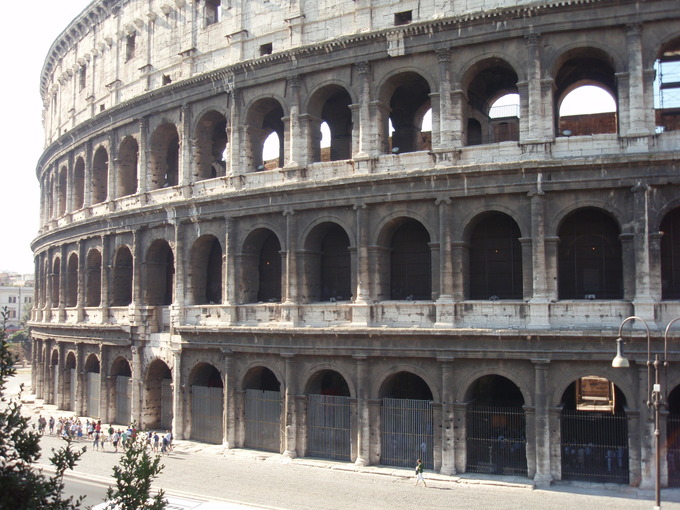
The building of the amphitheater began under Vespasian in 72 CE, and was completed under Titus in 80 CE. Titus inaugurated the amphitheater with a series of gladiatorial games and events that lasted for 100 days.
During his reign, Domitian remodeled parts of the amphitheater to enlarge the seating capacity to hold 50,000 spectators and added a hypogeum beneath the arena, for storage and to transport animals and people to the arena floor. The Colosseum was home not just to gladiatorial events—because it was built over Nero’s private lake, it was flooded to stage mock naval battles.
Like all Roman amphitheaters, the Colosseum is a free-standing structure, whose shape comes from the combination of two semi-spherical theaters. The Colosseum exists in part as a result of improvements in concrete and the strength and stability of Roman engineering, especially their use of the repetitive form of the arch. The concrete structure is faced in travertine and marble.
The exterior of the Colosseum is divided into four bands that represent four interior arcades. The arcades are carefully designed to allow tens of thousands of spectators to enter and exit within minutes. Attached to the uppermost band are over two hundred corbels which supported the velarium —a retractable awning to protect spectators from sun and rain. The top band is also pierced by a number of small windows, between which are engaged composite pilasters .
The three bands below are notable for the series of arches that visually break up the massive façade. The arches on the ground level served as numbered entrances, while those of the two middle levels framed statues of gods, goddesses, and mythical and historical heroes. Columns in each of the three Greek orders stand between the arches. The Doric order is located on the ground level, Ionic on the second level, and Corinthian on the third. The order follows a standard sequence where the sturdiest and strongest order is shown on bottom level, since it appears to support the weight of the structure, and the lightest order at the top. However, despite this illusion the engaged columns and pilasters were merely decorative.
Arch of Titus
Following his brother’s death, Domitian erected a triumphal arch over the Via Sacra, on a rise as the road enters the Republican Forum. The Arch of Titus honors the deified Titus and celebrates his victory over Judea in 70 CE. The arch follows the standard forms for a triumphal arch, with an honorific inscription in the attic, winged Victories in the spandrels , engaged columns, and more sculpture which is now lost.
Inside the archway at the center of the ceiling is a relief panel of the apotheosis of Titus. Two remarkable relief panels decorate the interior sides of the archway and commemorate Titus’s victory in Judea.
The southern panel inside the arch depicts the sacking of Jerusalem. The scene shows Roman soldiers carrying the menorah (the sacred candelabrum) and other spoils from the Temple of Jerusalem.
The opposite northern panel depicts Titus’s triumphal procession in Rome, awarded in 71 CE. In this panel, Titus rides through Rome on a chariot pulled by four horses. Behind him a winged Victory figure crowns Titus with a laurel wreath. He is accompanied by personifications of Honor and Valor.
This is one of the first examples in Roman art of humans and divinities mingling together in one scene; indeed, Titus was deified upon his death. These panels were originally painted and decorated with metal attachments and gilding. The panels are depicted in high relief and show a change in technical style from the lower relief seen on the Ara Pacis Augustae.

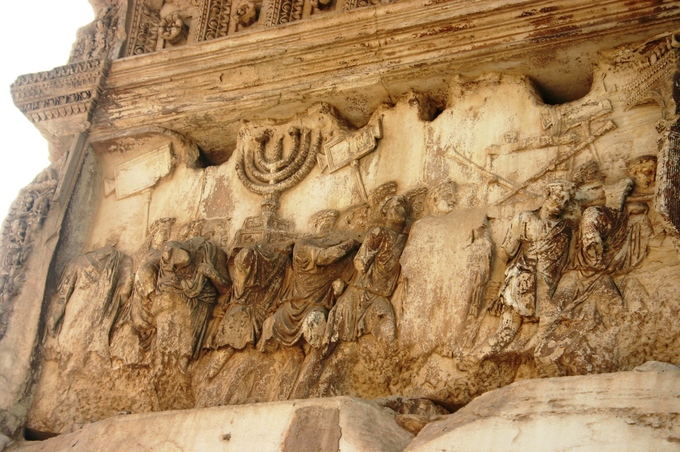
Painting in the Early Roman Empire
Roman frescoes were the primary method of interior decoration and their development is generally categorized into four different styles.
Compare and contrast the Pompeian First, Second, Third, and Fourth Styles of painting
Key Points
- The development of fresco -painting styles is a visual example of the changing tastes from the third century BCE through the first century CE. The change in styles reflects the changes that occurred in Roman society.
- Pompeiian First Style, which originated from the Greeks, is also known as masonry style. It mimics marble and colored stone to create the illusion of an expensive veneer. It was popular from 200 to 80 BCE.
- Pompeiian Second Style is known for its dissolution of the wall into an architectural vista that makes logical sense. This style was typically used from 80 to 20 BCE. Examples of this style adorn the walls of the Villa of Livia and the Villa of the Mysteries.
- Pompeiian Third Style is a whimsical style full of fanciful architecture and Egyptian motifs that focuses more on creating an ornate rather than realistic space . It also includes painted scenes floating on a monochromatic backdrop. This style became popular in 20 BCE until about 60 CE. Examples of this style can be found at the Villa of Agrippa Postumus.
- Pompeiian Fourth Style is a less ornamented but more complex reaction to Third Style. It borrows elements from the three preceding styles, including faux masonry, architectural vistas, ornamental decorations, and panels of painted scenes. Fourth-Style painting was popular during the first century CE. Examples of this style are found at the House of the Vettii and the House of the Tragic Poet, as well as in a contemporary scene of a riot at a local amphitheater.
Key Terms
- triclinium: Formal dining room.
- buon fresco: A painting that involves applying wet paint to wet lime plaster. As both components dry, a chemical reaction causes them to fuse together, literally making the painting part of the wall.
- encaustic: A wax-based paint that is fixed in place by heating; a painting produced using this paint.
- fresco: In painting, the technique of applying water-based pigment to lime mortar or plaster.
- Egyptomania: Roman fascination with all things related to Egypt following the death of Cleopatra in 31 BCE and the annexation of Egypt in 30 BCE.
- trompe l’oeil: A genre of still-life painting that exploits human vision to create the illusion that the subject of the painting is real.
Roman Painting
Roman painters often painted frescoes, specifically buon fresco , a technique that involved painting pigment on wet plaster. When the painting dried, the image became an integral part of the wall. Fresco painting was the primary method of decorating an interior space. However, few examples survive, and the majority of them are from the remains of Roman houses and villas around Mt. Vesuvius.
Other examples of frescoes come from locations that were buried (burial protected and preserved the frescoes), such as parts of Nero’s Domus Aurea and at the Villa of Livia. These frescoes demonstrate a wide variety of styles. Popular subjects include mythology, portraiture, still-life painting, and historical accounts.
The surviving Roman paintings reveal a high degree of sophistication. They employ visual techniques that include atmospheric and near one-point linear perspective to properly convey the idea of space. Furthermore, portraiture and still-life images demonstrate artistic talent when conveying real-life objects and likenesses. The attention to detail seen in still-life paintings include minute shadows and an attention to light to properly depict the material of the object, whether it be glass, food, ceramics , or animals.
Roman portraiture further exhibits the talent of Roman painters and often shows careful study on the artist’s part in the techniques used to portray individual faces and people. Some of the most interesting portraits come from Egypt, from late first century BCE to early third century CE, when Egypt was a province of Rome .

These encaustic on wood panel images from the Fayum necropolis were laid over the mummified body. They show remarkable realism , while conveying the ideals and changing fashions of the Egypto-Roman people.
Classification
At the end of the nineteenth century, August Mau, a German art historian, studied and classified the Roman styles of painting at Pompeii. These styles, known simply as Pompeian First, Second, Third, and Fourth Style, demonstrate the period fashions of interior decoration preferences and changes in taste and style from the Republic through the early Empire.
First Style
Also known as masonry style, Pompeian First Style painting was most commonly used from 200 to 80 BCE. The style is known for its deceptive painting of a faux surface; the painters often tried to mimic the richly veneered surfaces of marble, alabaster , and other expensive types of stone veneer.
This is a Hellenistic (Greek) style adopted by the Romans. While creating an illusion of expensive decor, First-Style painting reinforces the idea of a wall. The style is often found in the fauces (entrance hall) and atrium (large open-air room) of a Roman domus (house). A vivid example is preserved in the fauces of the Samnite House at Herculaneum.
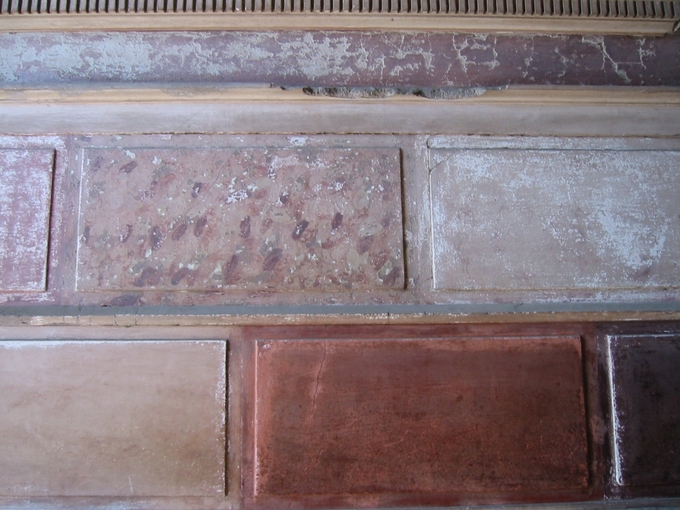
Second Style
Pompeiian Second Style was first used around 80 BCE and was especially fashionable from 40 BCE onward, until its popularity waned in the final decades of the first century BCE. The style is noted for its visual illusions. These trompe l’oeil images are intended to trick the eye into believing that the walls of a building have dissolved into the depicted three-dimensional space.
Wall frescoes were usually divided into three registers , with the bottom register depicting false masonry painted in the manner of the First Style, while a simple border was painted in the uppermost register. The central register, where the main scene unfolds, is the largest and the focal point of the painting. This space was an architectural zone that became the main component of Second-Style painting.
Typically, paintings that relied on near-perfect linear perspective to depict architectural expanses and landscapes that were painted on a human scale. The desired effect was to make the viewer feel as if, while in the room, he or she was physically transported to these spaces.

Villa of Livia
As the style evolved, the top and bottom registers became less important. Architectural scenes grew to incorporate the entire room, such as at the Villa of the Mysteries and the Villa of Livia.
In the case of the Villa of Livia, architectural vistas are replaced with a natural landscape that completely surrounds the room. The painting mimics the natural landscape outside the villa, depicting identifiable trees, flowers, and birds. Light filters naturally through the trees, which appear to bend in a slight breeze. Naturalistic elements like this, along with the flight of the birds and other details, help transport the occupant in the room into an outdoor setting.
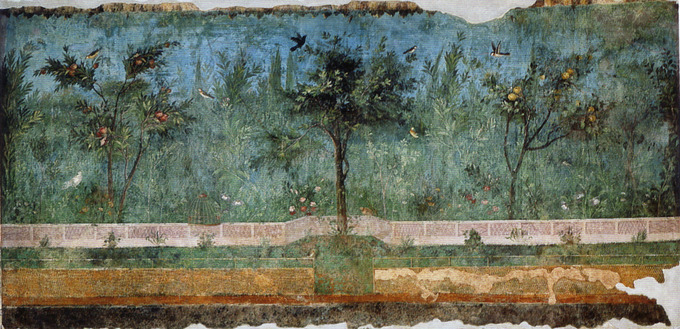
Villa of the Mysteries
At the Villa of the Mysteries, just outside of Pompeii, there is a fantastic scene filled with life-size figures that depicts a ritual element from a Dionysian mystery cult. In this Second-Style example, architectural elements play a small role in creating the illusion of ritual space. The people and activity in the scene are the main focus .
The architecture present is mainly piers or wall panels that divide the main scene into separate segments. The figures appear life-size, which brings them into the space of the room.
The scene wraps around the room, depicting what may be a rite of marriage. A woman is seen preparing her hair. She is surrounded by other women and cherubs while a figure, identified as Dionysus , waits. The ritual may reenact the marriage between Dionysus and Ariadne, the daughter of King Minos.
All the figures, except for Dionysus and one small boy, are female. The figures also appear to interact with one other from across the room. On the two walls in one corner, a woman reacts in terror to Dionysus and the mask over his head. On the opposite corner, a cherub appears to be whipping a woman on the adjoining wall. While the cult aspects of the ritual are unknown, the fresco demonstrates the ingenuity and inventiveness of Roman painters.
Third Style
Third-Style Pompeiian painting developed during the last decades of the first century BCE. It was popular from 20 BCE until the middle of the first century CE. During this period, wall painting began to develop a more fantastical personality.
Instead of attempting to dissolve the wall, the Third Style acknowledges the wall through flat, monochromatic expanses painted with small central motifs that look like a hung painting. The architecture painted in Third-Style scenes is often logically impossible. The wall is frequently divided into three to five vertical zones by narrow, spindly columns and decorated with painted foliage, candelabra, birds, animals, and figurines .
Often these creatures and people were derived from Egyptian motifs, resulting from a contemporary Roman fascination with Egypt known as Egyptomania , following the defeat of Cleopatra at Actium and the annexation of Egypt in 30 BCE.
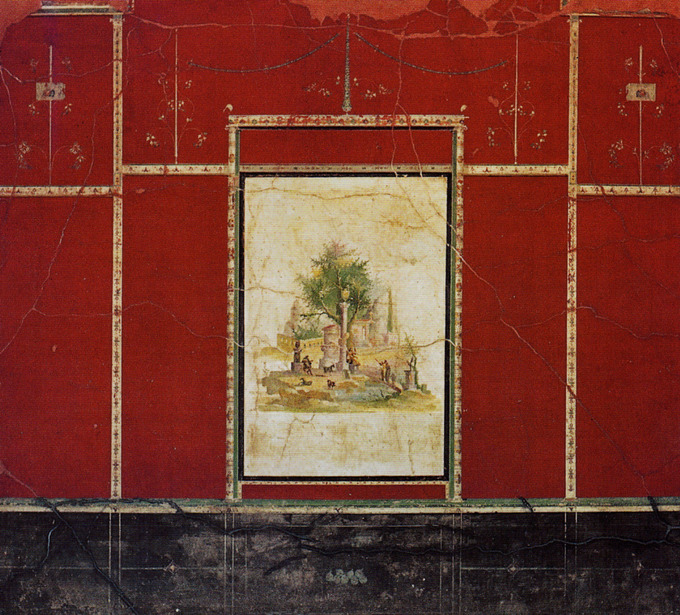
Fourth Style
The Pompeian Fourth Style became popular around the middle of the first century CE. While considered less ornate than the Third Style, the Fourth Style is more complex and draws on elements from each of the three previous styles.
In this style, masonry details of the First Style reappear on the bottom registers, and the architectural vistas of the Second Style are once more fashionable, although infinitely more complex than their Second-Style predecessors. Fantastical details, Egyptian motifs, and ornamental garlands from the Third Style continued into the Fourth Style. Large pictures, connected to each other by a program or theme, dominated each wall, such as those in the House of the Vettii.
House of the Vettii
Many rooms in the House of the Vettii are lavishly painted. Each triclinium is themed and painted in the Fourth Style. Each panel in the room follows the room’s theme, providing visual entertainment and a narrative during dining.
The Ixion Room, for instance, is a model of Fourth-Style wall painting. Within each red panel is a scene that depicts myths where the main character commits a major slight. One panel is dedicated to Ixion, who refused to pay a dowry and murdered his father-in-law. He also lusted after Zeus’s wife, betraying the relationship between guest and host.
Another panel depicts Daedalus presenting a wooden cow to Pasiphaë, the wife of King Minos, so she could relieve her lust for a white bull. From this union, Pasiphaë birthed the Minotaur , a half-man, half-bull monster. Another Fourth-Style triclinium depicts scenes from the lives of Hercules and Theseus.
House of the Tragic Poet
The atrium of the House of the Tragic Poet includes a series of paintings that depict scenes from the Trojan War. The panels on the walls depict scenes that appear to be interrelated. As in the panels that decorate the House of the Vettii, the subject matter in the paintings in the House of the Tragic Poet are interrelated based on a common theme. Scholars believe these themes were carefully crafted not only to relate stories, but also to depict the virtues of the house’s owner.
Two panels on the south wall relate the beginnings of the Trojan War. One panel is of Zeus and Hera on Mount Ida. Another, badly damaged, appears to be a scene of the Judgment of Paris. These panels relate the beginnings of the Trojan War while portraying womanly ideals.
Two pairs of scenes, set across from each other, depict different, interrelated themes. The abduction of women is one theme visible in one image of Helen with Paris leaving for Troy. Another image portrays the abduction of Amphitrite by Poseidon. In both cases, a man abducts a woman.
The other two scenes deal with the argument between Achilles and Agamemnon, which begins the story of the Illiad. Of these two scenes, one depicts Achilles with Agamemnon, while the other depicts Achilles returning Briseis, his lover and captive, to his commander, Agamemnon.
A final image, found in the peristyle , depicts the Sacrifice of Iphigenia. All of these paintings are related to one another through themes such as marriage, womanly virtue, and the Trojan War.
Riot at the Amphitheatre
While the above examples of Fourth-Style painting depict scenes from mythology, at least one contemporary scene is represented in a surviving fresco. In 59 CE, a riot broke out between the citizens of Pompeii and the citizens of nearby Nuceria during a gladiatorial event. The brawl in the amphitheater resulted in serious injuries between both parties and the banning of all gladiatorial events for ten years.
A fresco from Pompeii that depicts the event has also survived. The fresco depicts the Pompeiian amphitheater, with its distinctive exterior staircase, as well as an awning, the velarium . It also depicts the riot occurring both inside the arena and on the grounds surrounding the amphitheater.
Architecture at Pompeii
The eruption of Mount Vesuvius in 79 CE preserved many structures in the city of Pompeii, allowing scholars a rare glimpse into Roman life.
Describe the physical layout of the domus, or house, and describe the significances of the Amphitheater of Pompeii, the Temple of Isis, and the Suburban Baths
Key Points
- The main public part of the domus included the fauces, an entryway, the atrium , and the tablinum, a space for conducting business. The main private portions included the peristyle and garden and the triclinium or dining room. All components contained intricate decoration. Additional parts included a cubiculum, a kitchen, and open spaces known as alae.
- Pompeiian houses deviated greatly from the standard model created by historians. Examples demonstrate how the standard elements could be rearranged to fit almost any footprint and the wealth of the patron .
- The Amphitheater of Pompeii was the first stone amphitheater in the Roman world and the largest before the construction of the Colosseum. Its design foresees the construction of the Colosseum one century later, while simultaneously looking back to Greek theaters for its seating.
- The Temple of Isis exhibits elements of Greek, Roman, and Egyptian architecture. Its presence in a Roman city demonstrates religious tolerance and a willingness to incorporate foreign deities into the Roman pantheon .
- The Suburban Baths, while containing the standard tepidarium and caldarium of all Roman bath houses, has a single dressing room that archaeologists believe was used by both men and women.
Key Terms
- atrium: A square hall lit by daylight from above, into which rooms open at one or more levels.
- peristyle: A colonnade that surrounds a courtyard, temple, etc.
- patrician: Originally, a member of any of the families constituting the populus Romanus, or body of Roman citizens, before the development of the plebeian order; later, one who, by right of birth or by special privilege conferred, belonged to the senior class of Romans, who, with certain property, had by right a seat in the Roman Senate.
Mount Vesuvius and the Preservation of Pompeiian Architecture
During the Roman Republic and into the early Empire, the area today known as the Bay of Naples was developed as a resort-type area for elite Romans to escape the pressure and politics of Rome . The region was dominated by Mt. Vesuvius, which famously erupted in August 79 CE, burying and preserving the cities of Herculaneum and Pompeii, along with the region’s villas and farms.
When Vesuvius erupted on August 25, a cloud of ash spewed south, burying the cities of Pompeii, Nuceria, and Stabiae. While not everyone left prior to the eruption, archaeological evidence shows that people did leave the city. Some houses give the impression of having been packed up and in some cases furniture and objects were excavated jumbled together. Other objects of value appear to have been buried or hidden. There is evidence of people returning after the eruption to dig through the remains—either recovering lost goods or looting for valuables.
In Pompeii, an ash flow suffocated the remaining population and allowed all organic matter to decompose. However, where bodies and other organic objects (from bodies to wooden architectural frames) once lay or stood, empty cavities within the ash remained and preserved their outer forms .
A pyroclastic flow of superheated gas and rock went west to the coast and the city of Herculaneum. Unlike the ash blanket of Pompeii, the pyroclastic flow in Herculaneum petrified organic material, ensuring the preservation of human remains and wood, including the preservation of wooden screens, beds, and shelving. Many of the frescoes , mosaics , and other non-organic materials in both the ash and pyroclastic flows were preserved until their excavation in the modern period.
The Roman Domus
The Roman domus, or house, played two important roles in Roman society: as a home and as a place of business for patricians and wealthy Romans. To facilitate this dual functionality, the domus had a distinct set of rooms that could be used as either public or private spaces. While no modern domus adheres to the standard model of a domus, many Roman houses, both small and large, have nearly all of these different rooms.
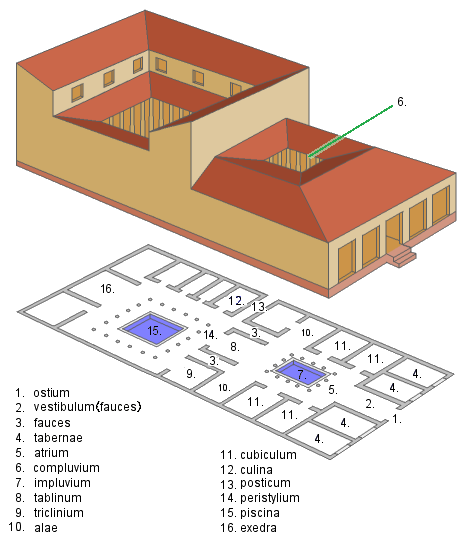
The design of the domus reflects the Roman patronage where a client is protected by a wealthy patron, and in return supports the actions and estate of the patron. Many of a patron’s clients would be freedmen or other plebeians and lesser patricians.
The domus is often set back from the main street, and tabernae (shops) line the streets on either side of the house’s main entrance. Clients entered the house through the fauces (Latin for jaw), which was a narrow entryway into an atrium.
The atrium was the most important part of the house since it was the spot where clients and guests were greeted. It often included an impluvium, or basin that collected rain water. The roof did not cover the impluvium. The open space above the basin was called the compluvium.
The atrium was often richly decorated with thematic frescos and images of the patron’s ancestors. Cubicula , or rooms, lined the atrium, and at the far end was the tablinum. The tablinum functioned as the office of the patron and was where he met with his clients during the morning ritual of salutatio. The tablinum often provided a glimpse into the private sphere of the house, which was set behind the office.
Typically, the front half of the house served as public space, while the back of the domus was reserved for the more private functions of the family. In the back of the house, beyond the tablinum, would be one or more triclinium (plural: triclinia), or dining rooms. The dining rooms were lavishly decorated and typically furnished with dining couches and a low table.
A peristyle—a colonnaded courtyard—was usually the main feature of the back of the house. It could contain gardens and even a pool and provided light as well as shade and breeze for hot summer days. Other features of the domus, include alae (open rooms) with an unknown function, kitchens (culina), and additional rooms for work, sleeping, and servants.
Domus at Pompeii
Each domus throughout Pompeii represents the various ways the standard components of a domus were used to create unique floor plans that showcase the status and wealth of the owner.
The large complex of the House of the Faun encompasses an entire city block. This domus has two atria, each with its own fauces, although with two peristyles of different sizes. In essence, the House of the Faun was a private villa despite its urban setting.
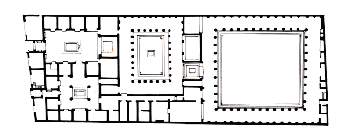
Two houses, the House of the Vettii and the House of the Tragic Poet—both previously discussed for their wall paintings—are simpler constructions than the House of the Faun, but both house plans still readily depict the wealth of the household.
Visitors entering the House of the Vettii were greeted by a frescoed image of Priapus, an image that portrayed the wealth and luck of the two bachelors who lived inside. The main attributes of their house were the atrium and the large garden peristyle, surrounded by decorated triclinium and a garden complete with fountains, statues, and flowers. While this house had fewer public-private access restrictions than the standard domus, it did include the main attributes of a traditional Roman house.
The House of the Tragic Poet was small but maintained the public-private access characteristic of the traditional domus. The fauces was especially noted for its mosaic image of a dog, complete with the warning “Cave canem,” or, roughly, “Beware of dog.” The fauces led the guest into the atrium and the tablinum, which divided the public front of the house from the private back of the house, where a small peristyle and a frescoed triclinium were located.
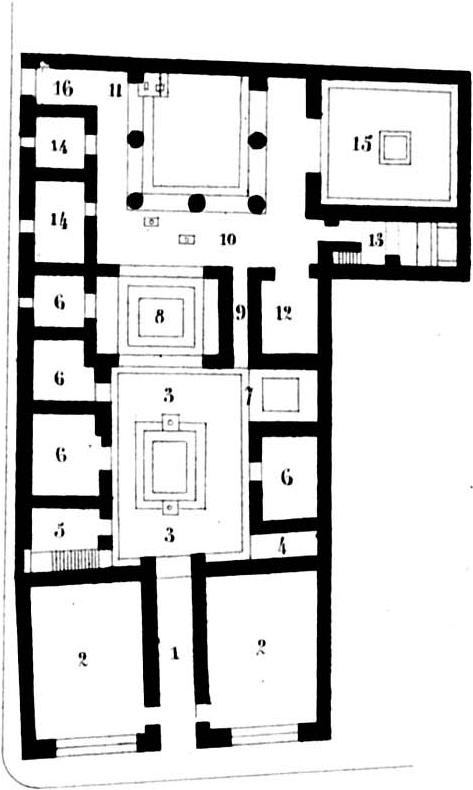
Public Architecture
The ash cloud that blanketed Pompeii in 79 CE preserved public buildings, as well as domi. Among the best preserved are the amphitheater, the Temple of Isis, and the Suburban Baths.
Amphitheater of Pompeii
The Amphitheater of Pompeii is the oldest surviving Roman amphitheater. Built around 70 BCE, the current amphitheater is the earliest Roman amphitheater known to have been built of stone. Previous amphitheaters were constructed of wood.
The design is seen by some modern crowd control specialists as near optimal. Similar to the Colosseum, but constructed over a century later, its arcaded exterior appears to have been conducive to efficient evacuation. Its washroom, located in the neighboring wrestling school, has also been cited as an inspiration for better bathroom design in modern stadiums.
Derived from the Greek words amphi (on both sides) and theatron (a place for viewing), an amphitheater combines two theaters into a circular or ovoid form. The interior of the amphitheater at Pompeii resembles two Greek theaters, with its tiered seating overlooking a central staging area. Still structurally and acoustically sound, the amphitheater was the site of notable rock concerts in 1971 and 2016.
Temple of Isis
Roman culture was accommodating of most of the religious beliefs of its conquered peoples, and often built temples and sanctuaries to non-Roman deities and incorporated them into their own pantheon. One such example is the Temple of Isis, dedicated to the Egyptian mother goddess.
The principal devotees of this temple are assumed to be women, freedmen, and slaves. Initiates of the Isis mystery cult worshiped a compassionate goddess who promised eventual salvation and a perpetual relationship throughout life and after death.
The temple’s design combines Roman, Greek, and Egyptian architectural elements. It is surrounded by brick columns faced with plaster in a stylized reed motif often found on Egyptian columns. Their general shape recalls both the Doric and Tuscan orders.
Like typical Roman temples, the portico and cella rest on a raised platform connected to the ground by a central stairway. The columns on the portico appear to have been Tuscan. To either side of the cella is an arched niche flanked by either Corinthian or Composite pillasters.
Suburban Baths
The Suburban Baths (c. late first century BCE), built against the city walls, served as a public bath house for the residents of Pompeii. The entrance to the Baths is through a long corridor that leads into the dressing room.
Excavation of the Baths revealed only one set of dressing rooms and has led archaeologists to believe that both men and women shared this facility. The dressing room then led to the tepidarium (lukewarm room), followed by the caldarium (hot room), both of which were standard in public baths throughout the empire.
- Curation and Revision. Provided by: Boundless.com. License: CC BY-SA: Attribution-ShareAlike
- August Labicana Massimo Inv56230. Provided by: Wikimedia. Located at: commons.wikimedia.org/wiki/File:August_Labicana_Massimo_Inv56230.jpg. License: CC BY-SA: Attribution-ShareAlike
- Ara Pacis Rom. Provided by: Wikimedia. Located at: commons.wikimedia.org/wiki/File:Ara_Pacis_Rom.jpg. License: CC BY-SA: Attribution-ShareAlike
- RomaAraPacis ProcessioneSudParticolare. Provided by: Wikimedia. Located at: commons.wikimedia.org/wiki/File:RomaAraPacis_ProcessioneSudParticolare.jpg. License: CC BY-SA: Attribution-ShareAlike
- mann6720_54.jpg. Provided by: Wikispaces. Located at: romansurvivalguide.wikispaces.com/file/view/mann6720_54.jpg/54180252/160x260/mann6720_54.jpg. License: CC BY-SA: Attribution-ShareAlike
- Statue-Augustus. Provided by: Wikimedia. Located at: commons.wikimedia.org/wiki/File:Statue-Augustus.jpg. License: CC BY-SA: Attribution-ShareAlike
- 360px-Statue_Claudius_Vatikanische_Museen.jpg. Provided by: Wikimedia Commons. Located at: commons.wikimedia.org/w/index.php?curid=16936276. License: CC BY-SA: Attribution-ShareAlike
- Marcus Vipsanius Agrippa. Provided by: Wikipedia. Located at: en.Wikipedia.org/wiki/Marcus_Vipsanius_Agrippa. License: CC BY-SA: Attribution-ShareAlike
- Julia the Elder. Provided by: Wikipedia. Located at: en.Wikipedia.org/wiki/Julia_the_Elder. License: CC BY-SA: Attribution-ShareAlike
- TIberius. Provided by: Wikipedia. Located at: en.Wikipedia.org/wiki/Tiberius. License: CC BY-SA: Attribution-ShareAlike
- Claudius. Provided by: Wikipedia. Located at: en.Wikipedia.org/wiki/Claudius. License: CC BY-SA: Attribution-ShareAlike
- Ara Pacis. Provided by: Wikipedia. Located at: en.Wikipedia.org/wiki/Ara_Pacis. License: CC BY-SA: Attribution-ShareAlike
- Pontifex Maximus. Provided by: Wikipedia. Located at: en.Wikipedia.org/wiki/Pontifex_Maximus. License: CC BY-SA: Attribution-ShareAlike
- Augustus. Provided by: Wikipedia. Located at: en.Wikipedia.org/wiki/Augustus%23Legacy. License: CC BY-SA: Attribution-ShareAlike
- Augustus of Prima Porta. Provided by: Wikipedia. Located at: en.Wikipedia.org/wiki/Augustus_of_Prima_Porta%23Divine_status. License: CC BY-SA: Attribution-ShareAlike
- Meander (Art). Provided by: Wikipedia. Located at: en.Wikipedia.org/wiki/Meander_(art). License: CC BY-SA: Attribution-ShareAlike
- Lictor. Provided by: Wikipedia. Located at: en.Wikipedia.org/wiki/Lictor. License: CC BY-SA: Attribution-ShareAlike
- Pomerium. Provided by: Wikipedia. Located at: en.Wikipedia.org/wiki/Pomerium. License: CC BY-SA: Attribution-ShareAlike
- Register (Sculpture). Provided by: Wikipedia. Located at: en.Wikipedia.org/wiki/Register_(sculpture). License: CC BY-SA: Attribution-ShareAlike
- 517px-Arch_Titus,_Forum_Romanum,_Rome,_Italy.jpg. Provided by: Wikimedia Commons. Located at: commons.wikimedia.org/w/index.php?curid=29534538. License: Public Domain: No Known Copyright
- Arch of titus relief 1. Provided by: Wikimedia. Located at: commons.wikimedia.org/wiki/File:Arch_of_titus_relief_1.jpg. License: CC BY-SA: Attribution-ShareAlike
- 360px-Domus_Aurea_Octagon.jpg. Provided by: Wikimedia Commons. Located at: commons.wikimedia.org/w/index.php?curid=39732186. License: CC BY-SA: Attribution-ShareAlike
- 640px-Basilica_Julia.jpg. Provided by: Wikimedia Commons. Located at: commons.wikimedia.org/w/index.php?curid=18437271%20. License: CC BY-SA: Attribution-ShareAlike
- Detail from Arch of Titus. Provided by: Wikimedia. Located at: commons.wikimedia.org/wiki/File:Detail_from_Arch_of_Titus.jpg. License: CC BY-SA: Attribution-ShareAlike
- Colosseum-exterior-2007. Provided by: Wikimedia. Located at: commons.wikimedia.org/wiki/File:Colosseum-exterior-2007.JPG. License: CC BY-SA: Attribution-ShareAlike
- Basilica. Provided by: Wikipedia. Located at: en.Wikipedia.org/wiki/Basilica. License: CC BY-SA: Attribution-ShareAlike
- Basilica Julia. Provided by: Wikipedia. Located at: en.Wikipedia.org/wiki/Basilica_Julia. License: CC BY-SA: Attribution-ShareAlike
- Grotesque. Provided by: Wikipedia. Located at: en.Wikipedia.org/wiki/Grotesque. License: CC BY-SA: Attribution-ShareAlike
- The Julio-Claudians. Provided by: Boundless Learning. Located at: www.boundless.com/atoms/11000. License: CC BY-SA: Attribution-ShareAlike
- Arch of Titus. Provided by: Wikipedia. Located at: en.Wikipedia.org/wiki/Arch_of_Titus. License: CC BY-SA: Attribution-ShareAlike
- Vespasian. Provided by: Wikipedia. Located at: en.Wikipedia.org/wiki/Vespasian. License: CC BY-SA: Attribution-ShareAlike
- Titus. Provided by: Wikipedia. Located at: en.Wikipedia.org/wiki/Titus. License: CC BY-SA: Attribution-ShareAlike
- Colosseum. Provided by: Wikipedia. Located at: en.Wikipedia.org/wiki/Colosseum. License: CC BY-SA: Attribution-ShareAlike
- Flavians. Provided by: Wikipedia. Located at: en.Wikipedia.org/wiki/Flavians. License: CC BY-SA: Attribution-ShareAlike
- Domitian. Provided by: Wikipedia. Located at: en.Wikipedia.org/wiki/Domitian%23Rise_of_the_Flavian_dynasty. License: CC BY-SA: Attribution-ShareAlike
- Year of the Four Emperors. Provided by: Wikipedia. Located at: en.Wikipedia.org/wiki/Year_of_the_Four_Emperors. License: CC BY-SA: Attribution-ShareAlike
- Apotheosis. Provided by: Wiktionary. Located at: en.wiktionary.org/wiki/apotheosis. License: CC BY-SA: Attribution-ShareAlike
- Spandrel. Provided by: Wiktionary. Located at: en.wiktionary.org/wiki/spandrel. License: CC BY-SA: Attribution-ShareAlike
- Damnatio Memoriae. Provided by: Wikipedia. Located at: en.Wikipedia.org/wiki/damnatio%20memoriae. License: CC BY-SA: Attribution-ShareAlike
- Menorah. Provided by: Wiktionary. Located at: en.wiktionary.org/wiki/menorah. License: CC BY-SA: Attribution-ShareAlike
- esco-iphigeneia-man-naples.jpeg. Provided by: Wikimedia Commons. Located at: https://commons.wikimedia.org/wiki/File:Fresco_Iphigeneia_MAN_Naples.jpg. License: Public Domain: No Known Copyright
- i-wandmalerei-amphitheater.jpeg. Provided by: Wikimedia Commons. Located at: en.Wikipedia.org/wiki/File:Pompeji_-_Wandmalerei_-_Amphitheater.jpg. License: Public Domain: No Known Copyright
- Villa-dei-misteri-pannel.jp.jpeg. Provided by: Wikimedia Commons. Located at: commons.wikimedia.org/wiki/File:Roman_fresco_Villa_dei_Misteri_Pompeii_005.jpg. License: Public Domain: No Known Copyright
- Casa dei vettii - pannel fresco. Provided by: Wikimedia. Located at: commons.wikimedia.org/wiki/File:Casa_dei_vettii_-_pannel_fresco.jpg. License: CC BY-SA: Attribution-ShareAlike
- Herculaneum Wall 1.Style. Provided by: Wikimedia. Located at: commons.wikimedia.org/wiki/File:Herculaneum_Wall_1.Style.jpg. License: CC BY-SA: Attribution-ShareAlike
- Rom-Villa-Livia. Provided by: Wikimedia. Located at: commons.wikimedia.org/wiki/File:Rom-Villa-Livia.jpg. License: CC BY-SA: Attribution-ShareAlike
- Fresco-Boscotrecase. Provided by: Wikimedia. Located at: commons.wikimedia.org/wiki/File:Fresco-Boscotrecase.jpg. License: CC BY-SA: Attribution-ShareAlike
- Scene 3, left. Provided by: Wikipedia. Located at: en.Wikipedia.org/wiki/File:Scene_3,_left.jpg. License: CC BY-SA: Attribution-ShareAlike
- Fayum-34. Provided by: Wikipedia. Located at: en.Wikipedia.org/wiki/File:Fayum-34.jpg. License: CC BY-SA: Attribution-ShareAlike
- i-casa-dei-vettii-pasiphae.jpeg. Provided by: Wikimedia Commons. Located at: commons.wikimedia.org/wiki/File:Pompeii_-_Casa_dei_Vettii_-_Pasiphae.jpg. License: Public Domain: No Known Copyright
- Painting. Provided by: Boundless Learning. Located at: www.boundless.com/atoms/10757. License: CC BY-SA: Attribution-ShareAlike
- Pompeiian Styles. Provided by: Wikipedia. Located at: en.Wikipedia.org/wiki/Pompeian_Styles. License: CC BY-SA: Attribution-ShareAlike
- Pompeii. Provided by: Wikipedia. Located at: en.Wikipedia.org/wiki/Pompeii. License: CC BY-SA: Attribution-ShareAlike
- Fresco. Provided by: Wikipedia. Located at: en.Wikipedia.org/wiki/Fresco%23Classical_antiquity. License: CC BY-SA: Attribution-ShareAlike
- Vesuvius. Provided by: Wikipedia. Located at: en.Wikipedia.org/wiki/Vesuvius. License: CC BY-SA: Attribution-ShareAlike
- August Mau. Provided by: Wikipedia. Located at: en.Wikipedia.org/wiki/August_Mau. License: CC BY-SA: Attribution-ShareAlike
- Roman Art. Provided by: Wikipedia. Located at: en.Wikipedia.org/wiki/Roman_art%23Painting. License: CC BY-SA: Attribution-ShareAlike
- Fayum Mummy Portraits. Provided by: Wikipedia. Located at: en.Wikipedia.org/wiki/Fayum_mummy_portraits%23Art-historical_significance. License: CC BY-SA: Attribution-ShareAlike
- Encaustic. Provided by: Wiktionary. Located at: en.wiktionary.org/wiki/encaustic. License: CC BY-SA: Attribution-ShareAlike
- Definition of Egyptomania in Art History. Provided by: Boundless Learning. Located at: www.boundless.com/art-history/definition/egyptomania. License: CC BY-SA: Attribution-ShareAlike
- Trompe l'oeil. Provided by: Wiktionary. Located at: en.wiktionary.org/wiki/trompe_l'oeil. License: CC BY-SA: Attribution-ShareAlike
- 609px-Brogi,_Giacomo_(1822-1881)_-_Pompei_-_Tempio_d'Iside_-_n._5038_-_ca._1870.jpg. Provided by: Wikimedia Commons. Located at: commons.wikimedia.org/w/index.php?curid=1503411%20. License: Public Domain: No Known Copyright
- Pompeii Region VI Insula 8 House 3 plan 01. Provided by: Wikimedia. Located at: commons.wikimedia.org/wiki/File:Pompeii_Region_VI_Insula_8_House_3_plan_01.jpg. License: CC BY-SA: Attribution-ShareAlike
- File:Casa dei vetti - planimetria.svg - Wikipedia. Provided by: Wikipedia. Located at: it.Wikipedia.org/w/index.php?title=File:Casa_dei_vetti_-_planimetria.svg&page=1. License: CC BY-SA: Attribution-ShareAlike
- 640px-Pompeji_-_Arena.jpg. Provided by: Wikimedia Commons. Located at: commons.wikimedia.org/w/index.php?curid=554974. License: CC BY-SA: Attribution-ShareAlike
- Domus romana. Provided by: Wikimedia. Located at: commons.wikimedia.org/wiki/File:Domus_romana.png. License: CC BY-SA: Attribution-ShareAlike
- 640px-Porta_Marina_(7238835816).jpg. Provided by: Wuikimedia Commons. Located at: commons.wikimedia.org/w/index.php?curid=30180123%20. License: CC BY-SA: Attribution-ShareAlike
- HoFBuildingPlan. Provided by: Wikipedia. Located at: en.Wikipedia.org/wiki/File:HoFBuildingPlan.gif. License: CC BY-SA: Attribution-ShareAlike
- ples-20-20vesuvius-20blast.jpeg. Provided by: Wikimedia Commons. Located at: commons.wikimedia.org/wiki/File:Mt_Vesuvius_79_AD_eruption.svg. License: CC BY-SA: Attribution-ShareAlike
- 640px-Anfiteatro_romano_Pompei.jpeg. Provided by: Wikimedia Commons. Located at: commons.wikimedia.org/w/index.php?curid=19173754. License: CC BY: Attribution
- Temple of Isis (Pompeii). Provided by: Wikipedia. Located at: en.Wikipedia.org/wiki/Temple_of_Isis_(Pompeii). License: CC BY-SA: Attribution-ShareAlike
- Amphitheatre of Pompeii. Provided by: Wikipedia. Located at: en.Wikipedia.org/wiki/Amphitheatre_of_Pompeii. License: CC BY-SA: Attribution-ShareAlike
- The Eruption of Mount Vesuvius. Provided by: Boundless Learning. Located at: www.boundless.com/atoms/10760. License: CC BY-SA: Attribution-ShareAlike
- Suburban Baths (Pompeii). Provided by: Wikipedia. Located at: en.Wikipedia.org/wiki/Suburban_Baths_(Pompeii). License: CC BY-SA: Attribution-ShareAlike
- Casa dei Vettii. Provided by: Wikipedia. Located at: it.Wikipedia.org/wiki/Casa_dei_Vettii. License: CC BY-SA: Attribution-ShareAlike
- Pompeii. Provided by: Wikipedia. Located at: en.Wikipedia.org/wiki/Pompeii. License: CC BY-SA: Attribution-ShareAlike
- Domus. Provided by: Wikipedia. Located at: en.Wikipedia.org/wiki/Domus. License: CC BY-SA: Attribution-ShareAlike
- House of the Vettii. Provided by: Wikipedia. Located at: en.Wikipedia.org/wiki/House_of_the_Vettii. License: CC BY-SA: Attribution-ShareAlike
- House of the Faun. Provided by: Wikipedia. Located at: en.Wikipedia.org/wiki/House_of_the_Faun. License: CC BY-SA: Attribution-ShareAlike
- House of the Tragic Poet. Provided by: Wikipedia. Located at: en.Wikipedia.org/wiki/House_of_the_Tragic_Poet. License: CC BY-SA: Attribution-ShareAlike
- Patrician. Provided by: Wiktionary. Located at: en.wiktionary.org/wiki/patrician. License: CC BY-SA: Attribution-ShareAlike
- Atrium. Provided by: Wiktionary. Located at: en.wiktionary.org/wiki/atrium. License: CC BY-SA: Attribution-ShareAlike
- Peristyle. Provided by: Wiktionary. Located at: en.wiktionary.org/wiki/peristyle. License: CC BY-SA: Attribution-ShareAlike


